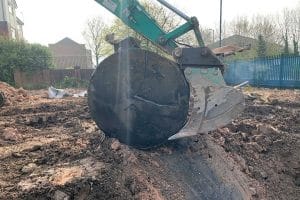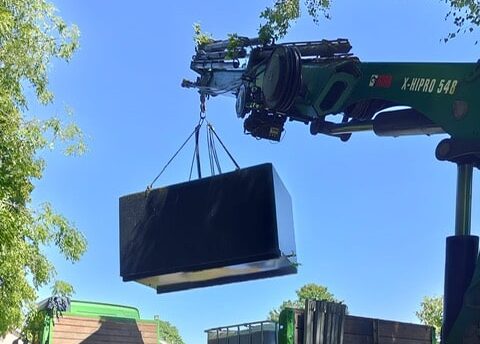 Oil Tank Removals – A Guide
Oil Tank Removals – A Guide
The object of this article is to give some information regarding oil tank removals, the methods used, and the reason for choosing that particular method. This guide includes information for both above and underground domestic and commercial fuel and oil storage tanks. It must be recognised that any works on fuel and oil tanks should be carried out by a competent and experienced contractor. The contractor should adopt practices in line with guidance such as ‘Design, Construction, Modification, Maintenance and Decommissioning of Filling Stations (4th Edition), OFTEC Technical Book 3, HSE Guidance and Best Practice and all legal duties set out under the Health and Safety at Work Act 1974.
Introduction to Oil Tank Removals
Before the removal and disposal of an old oil storage tank, its important that an OFTEC registered engineer carries out an assessment to decommission, remove and dispose of the old oil tank. Their task would be to identify any fire or environmental risks that may be associated with the process. The removal and disposal of oil tanks must be carried out according to existing building regulations. If you are looking to decommission an oil or fuel tank the most effective solution is often the simplest. That is, to simply empty, remove and dispose of it, eliminating any potential hazards it may cause. Alternative methods of decommissioning such as Foam Filling and Concrete Filling can also be implemented. Meaning the tank can be left in situ, or taken away at a later date.
Commercial Oil Tank Removals
Before a commercial tank removal can be begin, a site meeting may be necessary to assess the oil tank and survey the site for access. A safe system of working will be set out before any works begin. Including a method statement and risk assessments. We will contact your local petroleum licensing authority directly (if working with petrol), to inform them of the proposed work, and to submit the relevant documentation for approval.
Depending on whether the oil tank is above or below ground, an excavator may be needed to expose the tank. Our team would then begin to remove any remaining liquid that’s in the tank. Using specialised pumps and suction lines we can either transfer the fuel into another tank of your liking, or remove the fuel as waste. Our engineers will then disconnect and remove any current pipework feeding the tank (if required). We are now ready for safe removal of the redundant tank. If there is access to the tank, we can use a vehicle mounted crane to remove the tank in one piece. Otherwise, our engineers can utilise a combination of hot and cold cutting and make it more manageable to transport. Fue underground tanks, we use a network of accredited machine operators to excavate tanks, whilst they remain under a gas free certificate and our direct supervision.
Documentation will be given, including a consignment note and certificate of decommissioning. Furthermore, as we are fully licensed to transport hazardous waste, and we operate our own licensed waste transfer station, you can feel assured that you are meeting your obligations to safely dispose of hazardous waste in the appropriate manner.
Domestic Tank Removal Process
Similar to commercial tank removal a Domestic tank removal involves many of the same methods. The contents of the tank will be pumped out using an air operated pump and suction lines into suitable containers. We will then disconnect and remove any current pipework that is a part of the tank. Our engineers can then proceed to clean the internals of the tank of any sludges or waste, thus eliminating the risk of spillage or contamination.
Our oil tank removal services can adopt a number of methods in disposing of a tank, all of which are selected as part of a safe system of work. Tanks can be taken to our waste disposal site whole, if access is available for a vehicle with a mounted crane to be close enough. Alternatively, our team can cut up the old oil tank on site, using both hot and cold cutting techniques and the pieces subsequently removed.
Documentation will be given including a Duty of Care and Certificate of Decommissioning. Furthermore, as we are fully licensed to transport hazardous waste, and we operate our own licensed waste transfer station. You can feel assured that you are meeting your obligations to safely dispose of hazardous waste in the appropriate manner.
If the tank is underground, the above method still applies. However, excavation equipment would be needed in order to expose the tank as well as ventilation equipment.
Underground Petrol Tank Removal – Additional Information
Our safe systems of work adopt procedures, to ensure that petrol tanks are opened with non sparking tools in a restricted and monitored exclusion zone. The cleaning of petrol tanks is conducted under a confined space entry permit system (if entry required), using non sparking, plastic and intrinsically safe equipment.
Please remember, any works on fuel and oil tanks should be carried out by a competent and experienced contractor.
Safety is paramount on our sites. Our team always ensures the area is securely fenced to prevent any unauthorised entry. Underground tank removal can be intrusive, but we will always work tirelessly to ensure the impact on our client is minimal.
J. W. Hinchliffe (Tanks) Ltd
As a company, J W Hinchliffe (Tanks) Ltd have specialised in fuel and oil tank decommissioning for nearly 50 years. Using our own in-house team, we can offer a bespoke service to meet the needs of any client, from transport operators, to the construction and public sectors. If you would like to know more about the services we offer, please see our services page. If you would like to contact us directly, you can email [email protected] or call directly on 01132635163. You can speak immediately to an experienced tank decommissioning engineer.
All of our work is carried out in line with current best practice and legislation. You can read more industry news through organisations such as the APEA (Association for Petroleum & Explosives Administration) by clicking here.
You can follow us across our many social media channels here – LinkedIn, Instagram and Facebook

